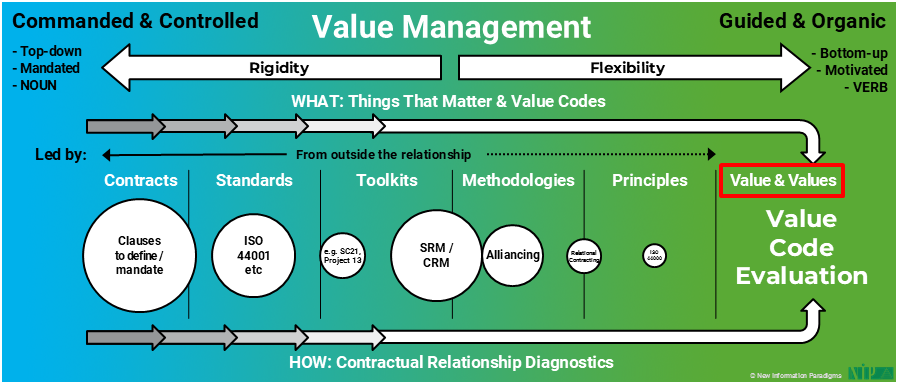Failed Approaches in Response to Complexity
The responses most organizations are making to the challenges of today’s commercial environment can be summarized as:
- Doubling-down – more of the same
- Short cuts – looking for quick fixes
- “Long” cuts – investments to pay off later
In many cases, organizations are adopting all three responses at the same time:
Doubling-down
Doubling-down is where organizations do pretty much what they’ve always done, but they do more of it and/or do it more emphatically, e.g.:
- Making contracts even more detailed and enforcing them even harder.
- Implementing standards.
- Delivering capability and/or behavioral training.
- Developing KPIs and gathering more data
- Restructuring roles and responsibilities.
Short cuts
Short cuts typically involve new technology (especially AI and Big Data), but could involve appointing a new CEO or getting in external consultancy, etc.
The common thread is looking for a quick fix that will “change the rules” – it may not really be clear how, but improvement will “inevitably” follow.
“Long” cuts
“Long” cuts are where organizations put things in place in the promise or hope that they will pay off later – often in the form of big consultancy-led programmes, but also some of the approaches found when Doubling-down or looking for Short cuts.
Instant results may not be expected, but – as with Short cuts – improvement will inevitably follow… somehow… at some point.
However, as is already evident in most cases through the (lack of) results, these responses aren’t just sub-optimal: they actively make things worse and are doomed to fail.
Why? Because they fail to understand one or more (often all) of:
- Complexity – how it accounts for and explains today’s intensifying challenges and guides how to respond to them effectively, rather than trying to control or sidestep them.
- People – how to recognize and best support how they need to think, organize and work in this complex environment, and which people need to be on board to make change happen.
- Value – how it is primarily subjective (going far beyond price and cost), how it can be understood and managed, and why it is the only effective and appropriate principle by which to navigate complexity.
Interestingly, in formulating his OODA loop – Observe, Orientate, Decide, Act, John Boyd implicitly recognised the importance of the Complexity, People, and Value dynamic, in ‘life or death’ combat situations.
Agility, adaptiveness and conscious awareness of unfolding circumstances is what sets Boyd’s and NIP’s approach from conventional, linear and often simplistic and rigid cause-and-effect thinking and processes.
Of course, ‘frozen-in-time’ methodologies and rules have their place, especially in narrow ‘exploit’ situations, but they must be consciously deployed and carefully monitored, or the consequences can be catastrophic, as Boyd pointed out.
Conventional Approaches Don’t Take Complexity Into Account
Conventional approaches have their place: we’re in no way suggesting that contracts should go in the bin, that standards have nothing useful to say, and so on.
However, the way they are currently being used fails to recognize the reality of Complexity and attempts (but fails) to work against it – instead treating reality as “complicated”:

This involves a set of fatal (albeit usually subconscious) misassumptions about the challenges faced:
- That they are knowable, and can be anticipated, mitigated against and “solved”.
- They can be clearly defined, are mostly tangible and remain static.
- They are the sum of their parts.
- That effectiveness in response requires prioritizing efficiency and optimization.
We have got here for several reasons:
- Human beings prefer order to “disorder”: we want things to be predictable and controlled, and we like (and take pride in) resolving challenges.
- This basic human trait has been further accentuated by the scientific method – reflected in the business world by Scientific Management – and by the Industrial Revolution, where scientific advances led the world to be understood principally as a “machine”.
- There are absolutely times when this more “mechanistic”, “command and control” approach absolutely makes sense, e.g. where things are predictable and unchanging, with optimization and efficiency paramount.
However, today’s environment and strategic relationships are dominated by the fuzzy and subjective, the unknown and the unpredictable, and by constant and rapid change.
Conventional Approaches Make Things Worse
Conventional approaches, as they are typically used, therefore create huge inefficiencies and waste:
- Standards and best practice guides: these are ever more detailed and to be implemented in full, by everyone – the assumption being that “a rising tide will float all boats” – but usually with little nuance for specific circumstances, such that resources are squandered.
- Organisational hierarchies: these are fixed and create bottlenecks at the “top” through which everything must flow “down”, delaying and distorting flows back “up” from the ground.
- Formal processes and structures: these artificially constrain information-exchange, networking and action, all of which need to be dynamic and rapid to encourage innovation, change and agility.
- Behavioral training: this implies that it is the people that are at fault – not the approaches and tools in use, from which behaviors emerge – which misses the point and actively demoralizes people.
Even the pursuit of technology usually involves a sense that all situations are ultimately reducible to a challenge of analysis and processing, with responsibility significantly “abdicated” to a “system” – both again missing the point and squandering the human intelligence available.
As a variant of the quote often attributed to Einstein puts it, “We cannot solve our problems with the same thinking we used when we created them”.
A new approach is needed to respond appropriately to Complexity – one rooted in Complexity itself by being centered on People, and led by Value.
That approach is Value Management.

Featured content:
- The Expectations Curve: when reality bites
- Simplicity the other side of Complexity
- Our series on Complexity
- ESG: A Case Study in Failure vs Value Management
Our series on Complexity-related failures:
- Introduction
- Part 1: Grenfell
- Part 2: Crossrail
- Part 3: HS2
- Part 4: London Terror Attacks
- Part 5: Boeing 737
(Now added to with further Boeing 737 issues)
Articles related to Failed Approaches:
The Transformation Needed for CCM: Part 2
Value is talked about everywhere, but it’s misunderstood. And this really matters because value is central to everything. Unfortunately, value isn’t properly in focus….
The Transformation Needed for CCM: Part 1
Value Management is what’s needed to truly transform the CCM role. But why is transformation needed? Because there are existential threats to the CCM role….
Understanding Diagnostics – don’t confuse them with surveys…
People typically don’t understand what a Diagnostic is. They then get all kinds of things wrong – especially in the conclusions they draw from them – and miss out significantly (even entirely) on the true insights and power that Diagnostics possess….
Negotiating Value in Contractual Relationships: Part 3
With a broader conception of “negotiation” in mind, we can now fill in the missing piece of our relationship management spectrum with Value Management: Things That Matter, Value Codes and Diagnostics….
Negotiating Value in Contractual Relationships: Part 2
Warranties, intellectual property rights, liquidated damages, and so on, are important. But it’s things like values, perceptions, effectiveness of communication, and behaviours that primarily affect contract delivery, and that determine the quality of the relationship. How do we “negotiate” those?…
Negotiating Value in Contractual Relationships: Part 1
Value is why we do anything: it’s the goal of our relationships, it’s what our contracts should support, and it’s what the negotiations for those contracts should focus on. But “value” is a much-misunderstood term……
Value Management: How to Avoid Being Overwhelmed
If they don’t realize it already, they will soon: anyone engaged in relationships is becoming overwhelmed by the difficulties and Complexity of decisions and trade-offs. Experience-based intuition currently bridges the gap, but it can’t scale and is doomed to fail. Here, we see the ideal…
The Case for Value Management: Part 3: Making it Happen
Pretty much every organization claims that value is a big deal to them. In this final part, we’ll look at the transformation involved with Value Management and how to make it happen – the people involved, the initial process and then how to spread and…








